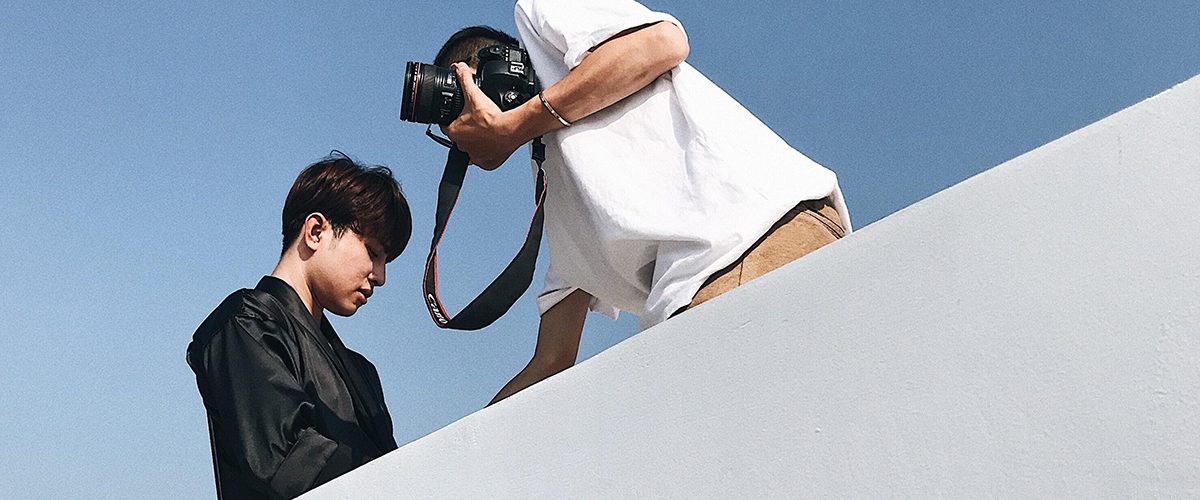Are there any rational reasons for the ideal measurements and the ideal age of a model? Maybe. But does a model have to be anorexic to get the best jobs? No.
To meet the requirements of the international model agencies and the media industry is as difficult as people think it is.

The huge amount of talented aspirants from all over the world makes it difficult to enter into the market. Many models start their career as a teenager. Models need a strong book and need to gain experience on runways and photo shootings. Between fashion shows, editorials and go-sees, there is often no time for personal interests, school and the cosiness of family and friends. To be a part of the fashion circus often also means to decide between youth or job, studies or book, family or agents etc.
As a New Face you need to look excellent, be young, tall and skinny, have a good education, language skills and lots of discipline. These are many requirements at the same time. We keep in mind that we are talking about teenagers who often do not have any other work experience. Whenever people chat about modelling you hear these rumours about big and easy money, travelling and meeting interesting people. In reality, only some dozens of models can be regarded as supermodels and some hundreds can be considered as top models with high salaries, while the vast majority of models have lower and medium incomes.
For those youngsters with an excellent agency, modelling can be an exciting challenge. The model career mostly depends on the efficiency of booking agents with contacts and imagination. Booking agents have to set up a model’s image and prepare their new incorporations for an international career.
Unfortunately, too many young models – mainly girls- are tempted by the world of wealthiness [money], glamour and the jet set. This is a dangerous trap and can lead to a world of depression, drug abuse, nutrition problems or plastic surgery. Fashion icons like Kate Moss show us that anorexia or mental-health problems also concern top players and not only youngsters. At the same time it seems that people need these headlines of celebrities in trouble to be aware of what is happening inside of the society.

In 2006, the decision of the local government of Madrid to ban anorexic models from the runways of the Cibeles Fashion Week, heated up discussions between fashion designers, model agents, event promoters and even politicians. For the first time in history laws were passed to prevent models from anorexia and even the houses Armani, Prada and Versace took the decision to apply stricter rules for the recruitment of models in terms of a minimum body-mass-index (BMI) and a minimum age.
It is difficult to define an ideal of a human being without entering into controversies, therefore we are grateful to contemplate projects like Sara Ziff’s and Ole Schell’s movie ‘Picture Me’, a documentary that was released in April 2009 and that gives interesting insights about fetishism, eating disorders and pays. As an ex-model, Ziff knows what she is talking about and it needs people like her to sensitise our society, but maybe we still need to mourn more victims like Gia Carangi or Ana Carolina Reston – talented young models that died as a result of drug addiction and anorexia.

On the other hand: Who cares about models? If you speak with a random person about the problems of a model, you will receive replies like: “So what? Can’t these chicks just do a job like anybody else?” Or you hear: “What about hundreds of kids that die in Africa each day! Great statements: Does anyone in the industrialized world care about children on the black continent?”
Campaigns like ‘No Anorexia’ by Oliveiro Toscani with the French actress Isabelle Caro bring it to the point: Only if you shock the society, you can change things. Caro is 165cm tall and had a weight of 32kg when Toscani shot her nude for billboards that were published during the fashion fair of Milan in 2007. Judge yourself if you like her look.
It is surprising that UK’s Vogue boss Alexandra Shulman recently complained about too skinny models and a textile industry that comes along with less fabric each season. Regardless of some years without dead models it seems that the public opinion demands more protection and more self-control from model agencies, casting directors and couturiers, the modelling industry reacts. Agencies will not lower their requirements, but more and more agencies are respecting the guidelines, that were defined in Madrid – due to ethical and PR reasons.
At the end it is the consumer who decides if he wants to see gorgeous fashion icons or skeletons on the international runways. My observation is, that the majority of young models live a normal life without depressions, drug or nutrition problems. It is also not fair to criticize the slimness of one group without asking for the sociological reasons of obeseness. We are professionals of the model circus and it is not our job to change the world, but it is our responsibility to inform youngsters about the requirements and potential dangers of the industry.

Modelling can be a fun and well-paid job too. We hope to see lots of great, healthy, happy and successful people on the runways and on high gloss posters, but we are tired of all these negative headlines about the model industry. We want to encourage all those models that meet the requirements of the industry to go on, we want to encourage these young talents to do sport and to work out, but we also recommend them that one’s health and happiness is more valuable than any tear sheets or glam covers. Those models with depressions and diseases, their parents and their bookers should know, that money and fame is not everything in life and that the pressure they apply is harmful and irresponsible.
Größer, schlanker, jünger, wo sind die Grenzen?
Gibt es rationale Gründe für ideale Modelmasse und das ideale Alter eines Models? Bestimmt. Aber muss ein Model magersüchtig sein, um die besten Jobs zu ergattern? Bestimmt nicht.
Die Anforderungen der Modelagenturen und der Medien sind ähnlich groß wie es der Laie erahnt.

Die Anzahl talentierter Modelanwärter aus aller Welt erschwert den Berufseinstieg. Viele der Models beginnen ihre Karriere bereits im Teenageralter. New Faces benötigen ein aussagekräftiges Buch und Erfahrungen auf Laufstegen und Fotoshootings. Zwischen Modenschauen, Editorials und Go-Sees bleibt oft wenig Freiraum für persönliche Interessen, Schule, Familie und Freunde. Am Modezirkus teilzuhaben geht daher nicht selten einher mit der Entscheidung zwischen Jugend oder Job, Weiterbildung oder Buch, Familie oder Agentur etc.
Newcomer müssen exzellent aussehen, müssen jung, groß und schlank sein, über ein gewisses kulturelles Niveau, Sprachkenntnisse und Disziplin verfügen. Das sind viele Anforderungen auf einmal, wenn wir bedenken, dass wir über Teenager sprechen, die vielfach nicht auf vorherige Berufserfahrung zurückblicken können. Wenn über den Modelmarkt geredet wird, treten häufig Gerüchte über schnell und einfach verdientes Geld, Reisen und ein Jet-Set-Dasein im Kreise illustrer und interessanter Leute zu Tage. In Wirklichkeit können nur wenige Dutzend als Supermodels bezeichnet werden, und nur einige Hundert können sich das Prädikat Topmodel auf die Fahne schreiben und entsprechende Honorare erzielen, während die Mehrheit der Darstellerinnen und Darsteller lediglich niedrige bis mittelmäßige Einkommen erzielt.
Für jene Einsteiger mit großartigen Repräsentanten kann modeln eine aufregende und positive Herausforderung sein. Die Karriere eines Models hängt überwiegend von Buchungsagenten mit Kontakten und Weitsicht ab. Die Aufgabe jener Booker ist es, das Image eines Models aufzubauen und seine Aspiranten für eine internationale Karriere vorzubereiten.

Leider sind zu viele junge Models – üblicherweise Mädchen – geblendet durch eine Welt des schnellen Geldes, Prestige und Jet Set, was sich als eine gefährliche Falle erweisen und in Depressionen, Drogenmissbrauch und Ernährungsproblemen ausufern kann. Modeikonen wie Kate Moss zeigen uns, dass Magersucht oder psychologische Störungen auch Top-Profis betreffen können. Auf der anderen Seite scheint es, dass der Leser einer Gazette gerade diese Schlagzeilen von bedeutenden Persönlichkeiten in Schwierigkeiten braucht, um darauf aufmerksam zu werden, was in unserer Gesellschaft vorgeht.
Die Entscheidung der lokalen Regierung von Madrid, magersüchtige Models von den Laufstegen der Modemesse Cibeles 2006 zu verbannen, löste heftige Diskussionen zwischen Designern, Modelagenten, Veranstaltern und sogar Politikern aus. Zum ersten Mal in der Geschichte wurden Gesetze verabschiedet, die Models vor Anorexie schützen sollen und selbst Häuser wie Armani, Prada und Versace sahen sich veranlasst, in Selbstkontrolle den verlautbarten Anforderungen an das Mindestalter und die Körpermassezahl (BMI) eines Models zu entsprechen.
Es ist schwer, ein Schönheitsideal zu definieren ohne sich in Kontroversen zu verstricken. Wir sind daher dankbar über Quellen wie den von Ole Shell und Sara Ziff im April 2009 veröffentlichten Dokumentarfilm ‘Picture Me’. Dieses Werk greift Themen wie Fetischismus, Essstörungen und exorbitante Modelgagen auf. Als Ex-Model weiß Sara wovon sie spricht und sicherlich brauchen wir mehr Persönlichkeiten wie sie, um unsere Gesellschaft zu sensibilisieren, auch wenn Horrormeldungen wie der Aids-Tod des Models Gia Carangi infolge von Drogenmissbrauch oder der Tod durch Magersucht des Armani-Models Ana Carolina Reston vermeintlich eine größere Massenwirkung haben.

Auf der anderen Seite: Wen interessiert schon ein Model? Wer sich mit den Problemen einer Laufstegschönheit beschäftigt erntet gerne Kommentare wie: „Können die Mädchen keine vernünftigen Berufe ausüben?“ Oder: „Und was ist mit den Hunderten von Kindern, die täglich in Afrika verhungern?“ Dabei wissen wir allzu genau, dass in unserer Industriegesellschaft wenige wirklich ernsthaft mit den Hungersnöten auf dem schwarzen Kontinent auseinandersetzen.
Kampagnen wie die Anzeige ‚No Anorexia’ des Fotografen Oliveiro Toscani, auf der die magersüchtige französische Schauspielerin Isabelle zu sehen ist bringen es auf den Punkt: Nur wer schockt, kann etwas bewegen. Caro hat eine Körpergröße von 165cm und wog 32kg als Toscani sie hüllenlos für Poster, die während der Mailänder Modemesse im Jahre 2007 ablichtete. Urteilen Sie selbst, ob Ihnen dieser Look gefällt.
Überraschenderweise beklagte sich erst kürzlich die Chefin der britischen Vogue über zu schlanke Models und über eine Bekleidungsindustrie, die Saison für Saison mit weniger Textil aufwartet. Trotz einiger Jahre ohne verhungerter Models scheint unsere Gesellschaft von den Modelagenturen, Casting-Direktoren und den Modemachern mehr Schutz für Models und mehr Selbstkontrolle zu fordern und scheinbar reagiert auch die Industrie. Es wäre vermessen zu glauben, dass Agenturen komplett von ihren Idealen abkommen, dennoch sind es eben diese ethischen Bedenken und nicht zuletzt PR-Gründe, die Agenturen veranlassen, die in Madrid definierten Richtlinien einzuhalten.

Am Ende entscheidet der Verbraucher ob er großartige Modeikonen oder Skelette auf den internationalen Laufstegen sehen will. Aus eigener Erfahrung behaupte ich, dass die meisten jungen Models ein normales Leben führen, nicht an Depressionen, Drogenmissbrauch oder an Essstörungen leiden. Es wäre auch nicht fair, die Schlankheit der einen zu kritisieren, ohne nach soziokulturellen Gründen für Phänomene wie Fettleibigkeit zu suchen. Als Branchenprofis ist es auch nicht unsere Aufgabe die Welt zu verbessern, aber wir sollten es als unsere Verantwortung sehen, Newcomer hinreichend über die Anforderungen und über potentielle Risiken aufzuklären.
Modelling kann ein interessanter und gut bezahlter Job sein. Wir wünschen uns auch weiterhin schöne, zufriedene und erfolgreiche Amazonen auf Laufstegen und Billboards, aber wir sind all der negativen Schlagzeilen in Verbindung mit der Modelindustrie überdrüssig. Wir wollen alle talentierten Aspiranten ermutigen, Sport zu treiben und sich entsprechend in Form zu bringen, auf der anderen Seite sind wir davon überzeugt, dass die Gesundheit des Einzelnen wichtiger ist als Tear Sheets oder Hochglanzplakate. Allen Models mit Depressionen und psychosomatischen Anfälligkeiten, ihre Eltern und ihre Buchungsagenten sollten sich dessen bewusst sein, dass Geld und Berühmtheit nicht alles im Leben ist und dass der von ihnen angewandte Leistungsdruck unverantwortlich und schädlich sein kann.


![Reblog this post [with Zemanta]](http://img.zemanta.com/reblog_e.png?x-id=b3ebf0cd-5675-4782-8ba4-3e093317801b)




An interesting point!
I see a lot of young girls being influenced and pressured to eat unhealthily. Things like minumum BMI and age rules can probably be helpful, but nobody wants to rock the boat. I hope things change for the better in the future.
There are NO LIMITS:
Much Taller,
Much Skinnier,
Much Younger…
MUCH BETTER!!
Today you must be:
– over 6 feet tall
– less than 100 lbs
– younger than 20 y.o.
GOOD LUCK!!
I don’t think it’s just ethical and PR reasons that agencies are abiding by guidelines, I think there is a shift in public expectation. The consumer always dictates the popularity of a look and these days consumers want models to look healthy. It seems to me that naturally thin is acceptable to the audience but starvation is not.
Personally I welcome this new, healthy way of thinking.
Is very nice…………
it`s true, but there`s a thin line between this and how they want you to be.
Ive seen cancer patients with more meat on them than these women!
I feel very sorry for them!It’s almost like watching a starving dog begging for food..it makes you just want to feed them and make them healthy again :(!
Well this is how their world wants people to look like ! Their world wants young girls to think that being as thin as these models is being healthy and beautiful. Sad but true. I don’t even feel sorry for them, they chose to be this way because they thought they couldn’t do anything more with their lives !
Thanks for the interesting content!!!
Some of those pictures are photoshopped to make the girls look skinnier than they actually are…
PRO_ANA have you ever wondered that maybe taller girls want to be smaller? i’m 175 cm tall and i dont want anything more then be 5 cm shorter !!
if this is what people believe beautiful is, starving yourself to be skinnier than someone else, that is bad, unhealthy, stupid! sure, be skinny, but don’t starve yourself! my uncle works in a hospital, working with this kind of stuff, he says if you get sick you lose weight, and may have to get a tube down your throat to help survive.
Haha! To that person who posted up 2 comments they would like to be 5 cms shorter, I would MORE THAN GLADLY take those 5cms from you!!
Im 162. Its so frustrating!
I would love to be 180….
Oh the things I could wear!!
This is a well done and fascinating article.